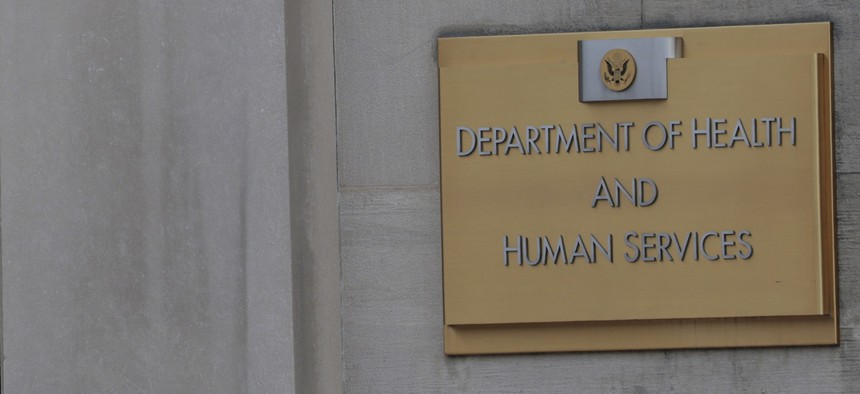
The FDA has also conducted a reduction in force of career staff throughout the tech office, including the entire Office of Enterprise Portfolio Management, according to the two current employees. Anna Moneymaker / Getty Images
Deep cuts hit HHS tech offices
Current employees say that dramatic cuts to leadership and career staff within FDA and HHS have left critical projects at risk.
As the Department of Health and Human Services looks to slash its workforce by 20,000, its tech shops are feeling the squeeze, potentially leaving key technology work in the lurch.
Most of the Food and Drug Administration’s executive leadership in its Office of Digital Transformation were put on administrative leave on April 1, two employees at the FDA told Nextgov/FCW. Like other current employees in this story, they were granted anonymity as they weren’t authorized to speak on the record.
Those targeted include the FDA's chief information officer, chief technology officer, executive officer of the Office of Digital Transformation and director of the Office of Technology and Delivery, said one current employee. The group was told that they’ll be separated from the organization on June 2.
The FDA has also conducted a reduction in force of career staff throughout the tech office, including the entire Office of Enterprise Portfolio Management, according to the two current employees.
“All strategy, architecture and design and financial/contract management and governance capabilities have been eliminated,” said one of them. “Everything strategic is gone. Tactical operation and cybersecurity is all that remains.”
Combined with staff taking the deferred resignation offer made earlier this year, the cuts have brought the staff of the FDA’s tech office down by about 40% compared to its former workforce, the two estimated.
In the CIO shop, only the cyber leadership and leader for operations and support weren't put on administrative leave.
“There’s really been absolutely no transparency. The remaining staff have received zero communication,” one of the employees said. “We don’t know who’s going to be taking on this work, and we don’t know who will be leading these critical systems. We store billions of dollars in industry trade secrets. … Nobody’s really thinking about the very real risk and impact.”
“At this point, we essentially have an agency of investigators and scientific reviewers, but we don't have leaders or people to actually ensure that the infrastructure operates effectively and doesn't completely crumble,” they added.
The assumption among some employees is that the department wants to centralize its IT, rather than have it managed individually at the separate subcomponents. The administration has said that the HHS restructuring will include consolidating the 28 divisions within HHS into 15.
Currently, HHS has different chief information officers for different service divisions and components, like the National Institutes of Health or Centers for Disease Control and Prevention.
But at the same time, the department has also cut staff within its central HHS Office of the Chief Information Officer. That office has generally acted as a “convener” across the federated department, said one of the FDA employees.
HHS eliminated nearly half of the staff within its tech office as part of reductions in force on April 1, according to two HHS employees, one of whom noted that — if others are correct about the department potentially trying to centralize its tech into HHS headquarters — there is no longer sufficient staff at HHS to do that work.
Within the HHS CIO shop, all of its senior executive service employees were reassigned to the Indian Health Service with limited relocation options in Montana, Alaska and Oklahoma, two employees told Nextgov/FCW.
The Indian Health Service “has long faced challenges related to staffing shortages,” so “HHS has invited certain individuals to consider positions within the IHS. These invitations are voluntary, and individuals have the option to accept or decline,” an HHS spokesperson told Nextgov/FCW.
The HHS chief information officer, Jennifer Wendel, is leaving at the end of the month, said one current employee. The CIO shop already has a new Palantir veteran, Clark Minor, working in a senior role. One of the current employees said Minor is the department's CTO, though Bloomberg has reported that he is the CIO.
Recent cuts at HHS were focused on “redundant or unnecessary administrative positions,” the spokesperson said, noting that “despite only having 28 divisions, HHS had 41 chief information officers.”
Some of those tech roles and offices could be consolidated, one of the FDA employees told Nextgov/FCW, but only to a point. The FDA has a different mission and needs different technology than the Centers for Disease Control and Prevention or the National Institutes of Health.
Within HHS, employees say that the cuts put critical systems at risk, given that it’s not clear who will now be able to manage the tech office’s department-wide systems like payroll and timesheets.
The tech office’s Office of Enterprise Services, for example, laid off all of its staff, according to two HHS employees. That office managed department-wide software licensing and the department’s enterprise infrastructure solutions telecom contract.
Both emphasized the haphazard nature of the cuts and the lack of planning or guidance for how the work of those laid off will now be done.
“Everything that enables the department’s digital backbone — circuits, cloud, telecom, even 1-800-Medicare — is at risk,” said one of the current employees. “There’s no acquisition authority, no fiscal oversight, and no strategic continuity.”







